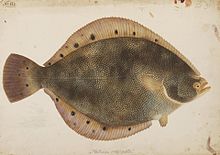
Flounders are a group of flatfish species. They are demersal fish, found at the bottom of oceans around the world; some species will also enter estuaries.

A flatfish is a member of the ray-finned demersal fish order Pleuronectiformes, also called the Heterosomata, sometimes classified as a suborder of Perciformes. In many species, both eyes lie on one side of the head, one or the other migrating through or around the head during development. Some species face their left sides upward, some face their right sides upward, and others face either side upward.
Chinese surnames are used by Han Chinese and Sinicized ethnic groups in China, Taiwan, Korea, Vietnam, and among overseas Chinese communities around the world such as Singapore and Malaysia. Chinese surnames are given first for names written in Chinese, which is the opposite of Western naming convention where surnames come last. Around 2,000 Han Chinese surnames are currently in use, but the great proportion of Han Chinese people use only a relatively small number of these surnames; 19 surnames are used by around half of the Han Chinese people, while 100 surnames are used by around 87% of the population. A report in 2019 gives the most common Chinese surnames as Wang and Li, each shared by over 100 million people in China, with Zhang, Liu, Chen, Yang, Huang, Zhao, Wu and Zhou making up the rest of the ten most common Chinese names.

Halibut is the common name for two flatfish in the genus Hippoglossus from the family of right-eye flounders and, in some regions, and less commonly, other species of large flatfish.
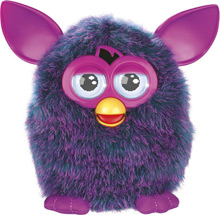
Furby is an American electronic robotic toy that was originally released in 1998 by Tiger Electronics. It resembles a hamster or owllike creature and went through a period of being a "must-have" toy following its holiday season launch, with continual sales until 2000. Over 40 million Furbies were sold during the three years of its original production, with 1.8 million sold in 1998, and 14 million in 1999. Its speaking capabilities were translated into 24 languages.

Citharichthys is a genus of flatfish in the large-tooth flounder family, Paralichthyidae. They have both eyes on the left sides of their heads. They are native to the oceans around the Americas, with a single species, C. stampflii off the West African coast. Most are found in relatively shallow depths, but the genus also includes species found in deep water and species that enter fresh water.

Pleuronectidae, also known as righteye flounders, are a family of flounders. They are called "righteye flounders" because most species lie on the sea bottom on their left sides, with both eyes on their right sides. The Paralichthyidae are the opposite, with their eyes on the left side. A small number of species in Pleuronectidae can also have their eyes on the left side, notably the members of the genus Platichthys.

Demersal fish, also known as groundfish, live and feed on or near the bottom of seas or lakes. They occupy the sea floors and lake beds, which usually consist of mud, sand, gravel or rocks. In coastal waters they are found on or near the continental shelf, and in deep waters they are found on or near the continental slope or along the continental rise. They are not generally found in the deepest waters, such as abyssal depths or on the abyssal plain, but they can be found around seamounts and islands. The word demersal comes from the Latin demergere, which means to sink.

The starry flounder, also known as the grindstone, emery wheel and long-nosed flounder, is a common flatfish found around the margins of the North Pacific.

The yellowbelly flounder is a flatfish of the genus Rhombosolea, found around New Zealand. A different species from the genus Rhombosolea is found in Australia and also goes by the name yellow-belly flounder. The Māori people have commonly fished for R.leporina, and many other species of flatfish, throughout New Zealand's coastal waters for hundreds of years. The Māori name for this species is 'patiki totara'.
The Kombai are a Papuan people of Melanesia living in the Indonesian province of Papua in Western New Guinea.
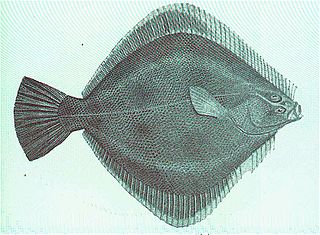
The New Zealand sand flounder is a righteye flounder of the genus Rhombosolea, found around New Zealand in shallow waters down to depths of 100 m.

The New Zealand turbot, Colistium nudipinnis, is a righteye flounder of the subfamily Rhombosoleinae in the family Pleuronectidae, found around New Zealand in shallow enclosed waters.
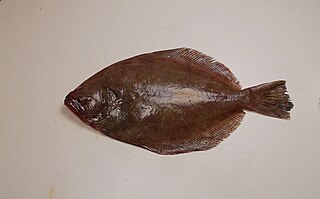
Paralichthys lethostigma, the southern flounder, is a species of large-tooth flounders native to the eastern and gulf coasts of the United States. It is a popular sports fish and is the largest and most commercially valuable flounder in the western North Atlantic Ocean and Gulf of Mexico. It is a "left-eyed flounder", meaning the left side is pigmented and is the "up side".

The Kamchatka flounder, Atheresthes evermanni, is a flatfish of the family Pleuronectidae. It is a demersal fish that lives at depths of between 20 metres (66 ft) and 1,200 metres (3,900 ft). Its native habitat is the temperate waters of the northern Pacific. It can grow as long as 100 centimetres (39 in) in length, and can weigh up to 8.5 kilograms (19 lb).
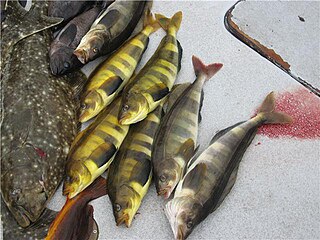
The Atka mackerel is a mackerel in the family Hexagrammidae. Atka mackerel are common to the northern Pacific ocean, and are one of only two members of the genus Pleurogrammus - the other being the Arabesque greenling. The Atka mackerel was named for Atka Island, the largest island of the Andreanof islands, a branch of the Aleutians.
Thysanopsetta naresi is a species of flatfish in the large-tooth flounder family, Paralichthyidae. It is the only member of its genus Thysanopsetta . Thysanopsetta naresi is a demersal fish that lives in temperate waters at depths of between 90 and 170 metres. It can be found in the southeast Pacific Ocean, off the coast of Chile, and in the southwest Atlantic Ocean in the Patagonian Falkland region. It grows to around 15.1 centimetres (5.9 in) in length.
Citharichthys gymnorhinus, the anglefin whiff, is a species of flatfish in the large-tooth flounder family Paralichthyidae. It is a demersal marine fish that inhabits the mid to outer continental shelf of the western Atlantic Ocean, in both tropical and subtropical waters. It ranges from the Bahamas and Florida in the north to Guyana and Nicaragua in the south, though larvae samples have also been collected off the coast of Canada. It occurs at depths between 35 and 200 metres, but is most commonly found in shallower waters.
Pseudomancopsetta andriashevi, the Pygmy flounder, is a species of southern flounder known from deep waters off of the southern coast of Chile as well as from around the Crozet Islands and Prince Edward Islands where it occurs at depths of from 200 to 365 metres. This species grows to a length of 11 centimetres (4.3 in) SL. This species is the only known member of its genus.

Citharichthys cornutus, the horned whiff, is a species of flatfish in the large-tooth flounder family Paralichthyidae. This bathydemersal marine fish inhabits the continental shelves of the western Atlantic Ocean, in both tropical and subtropical waters. It ranges from New Jersey in the north to Uruguay in the south, though larvae samples have also been collected off the coast of Canada. It occurs at depths between 30 and 400 metres, though it is usually found in deeper waters.
